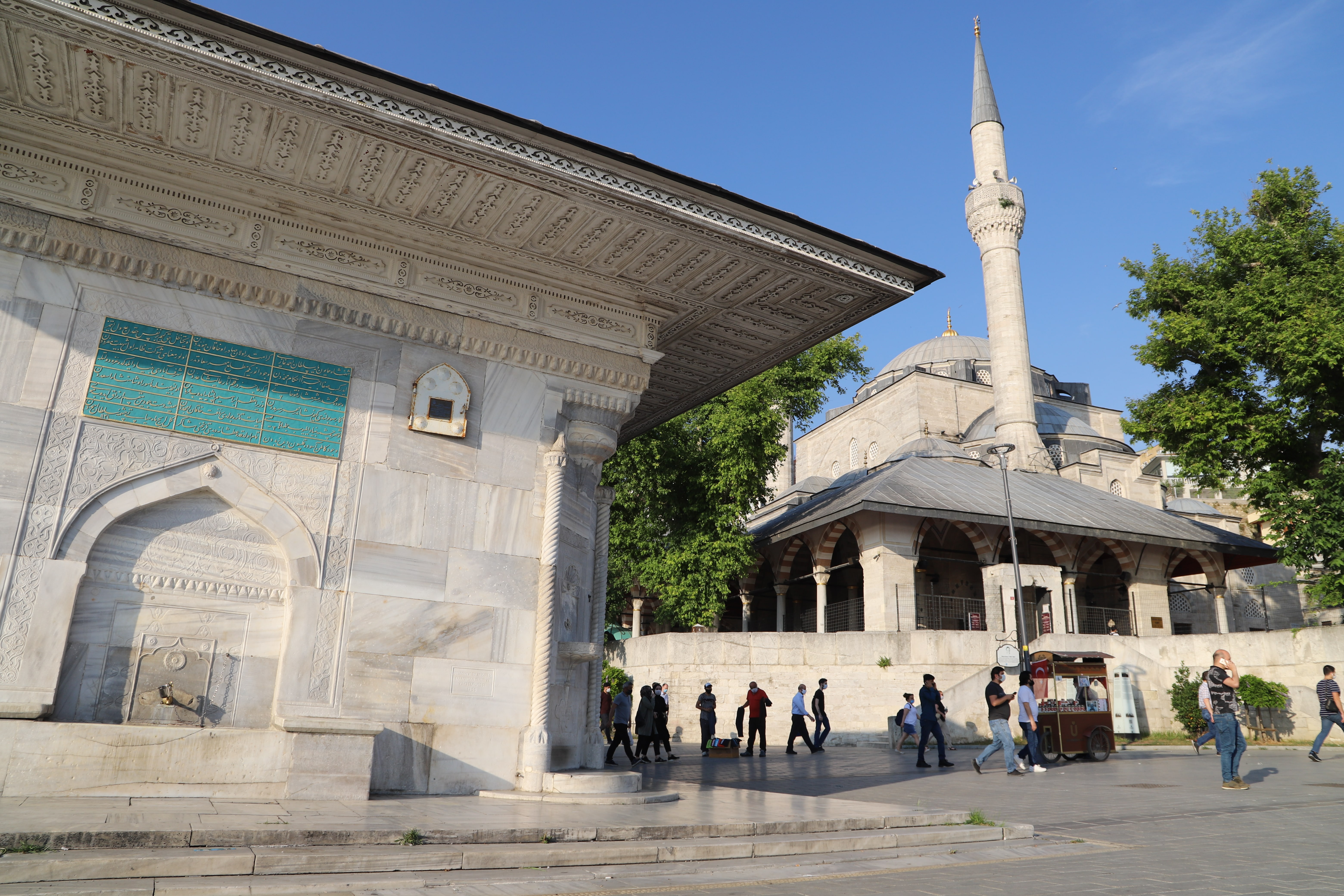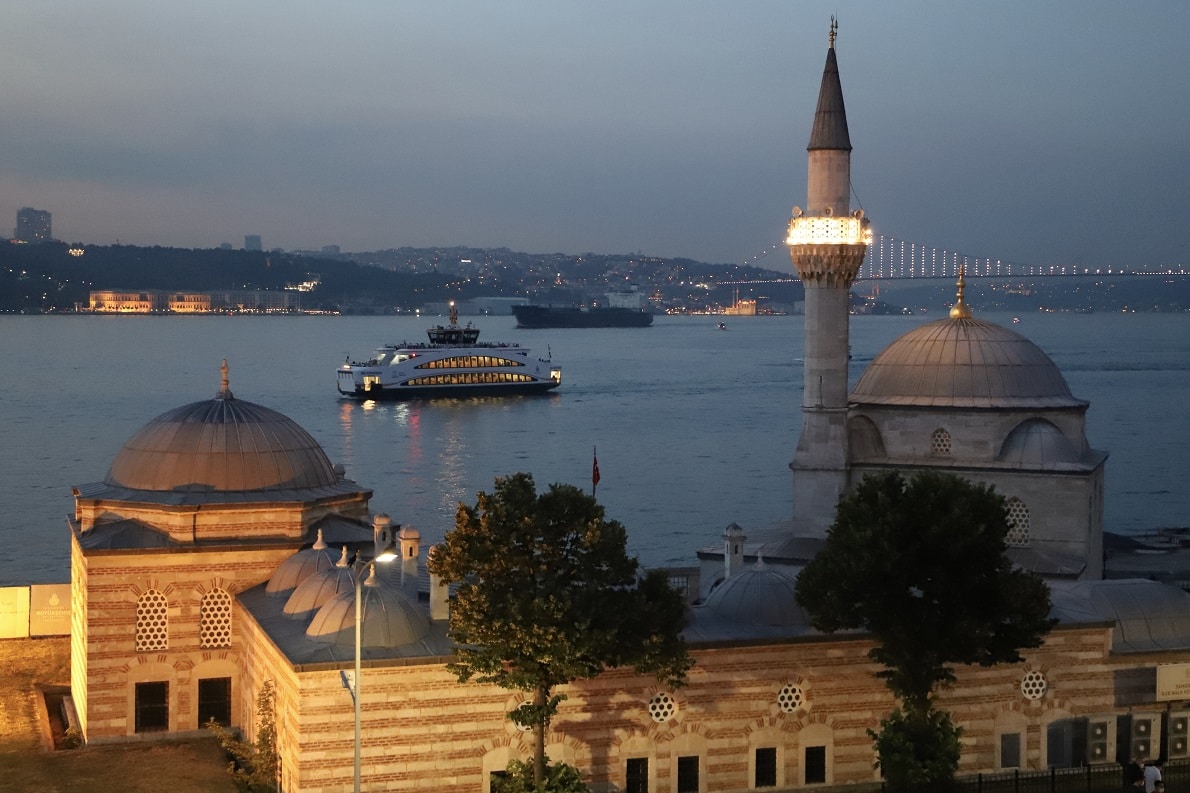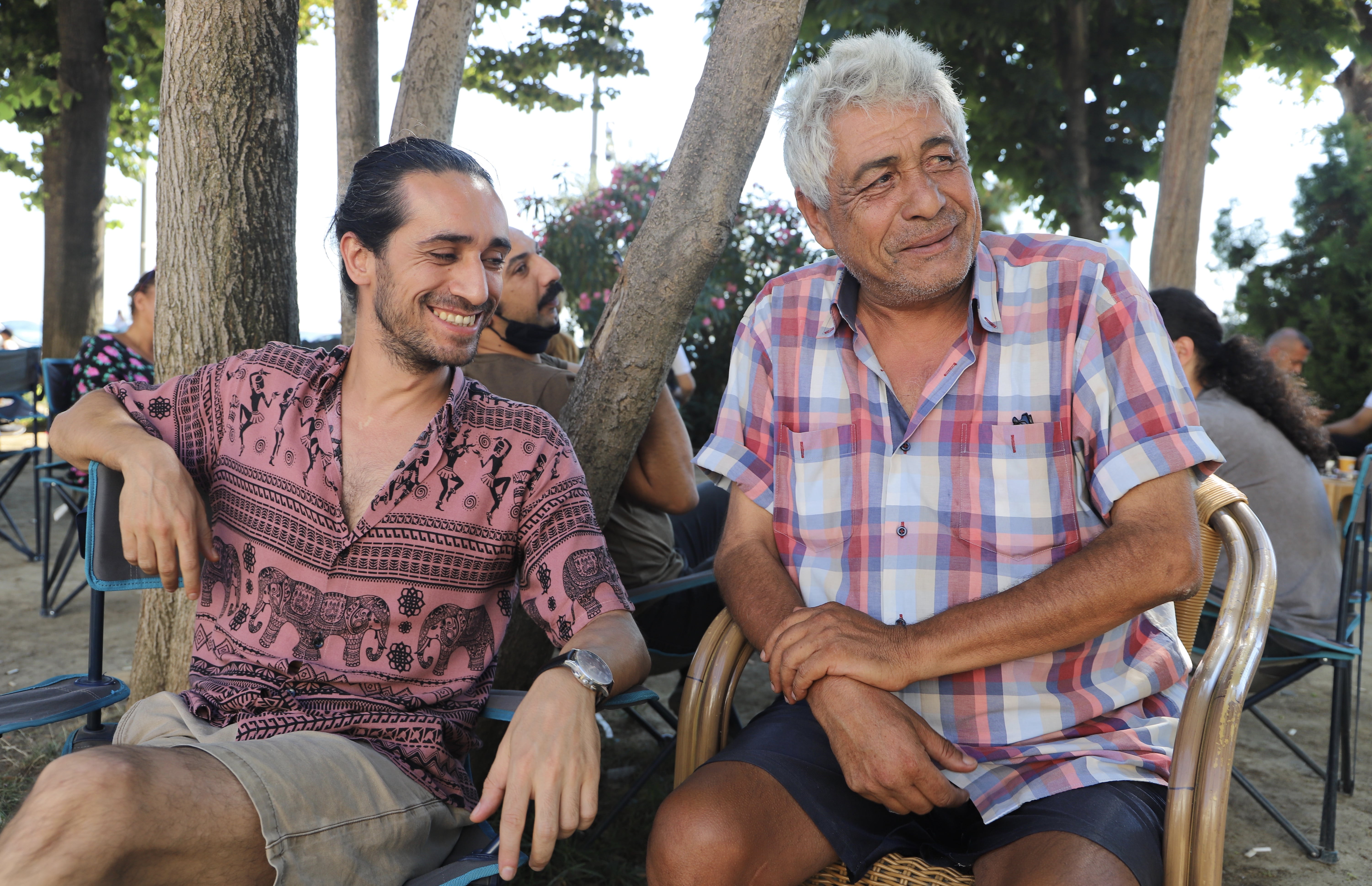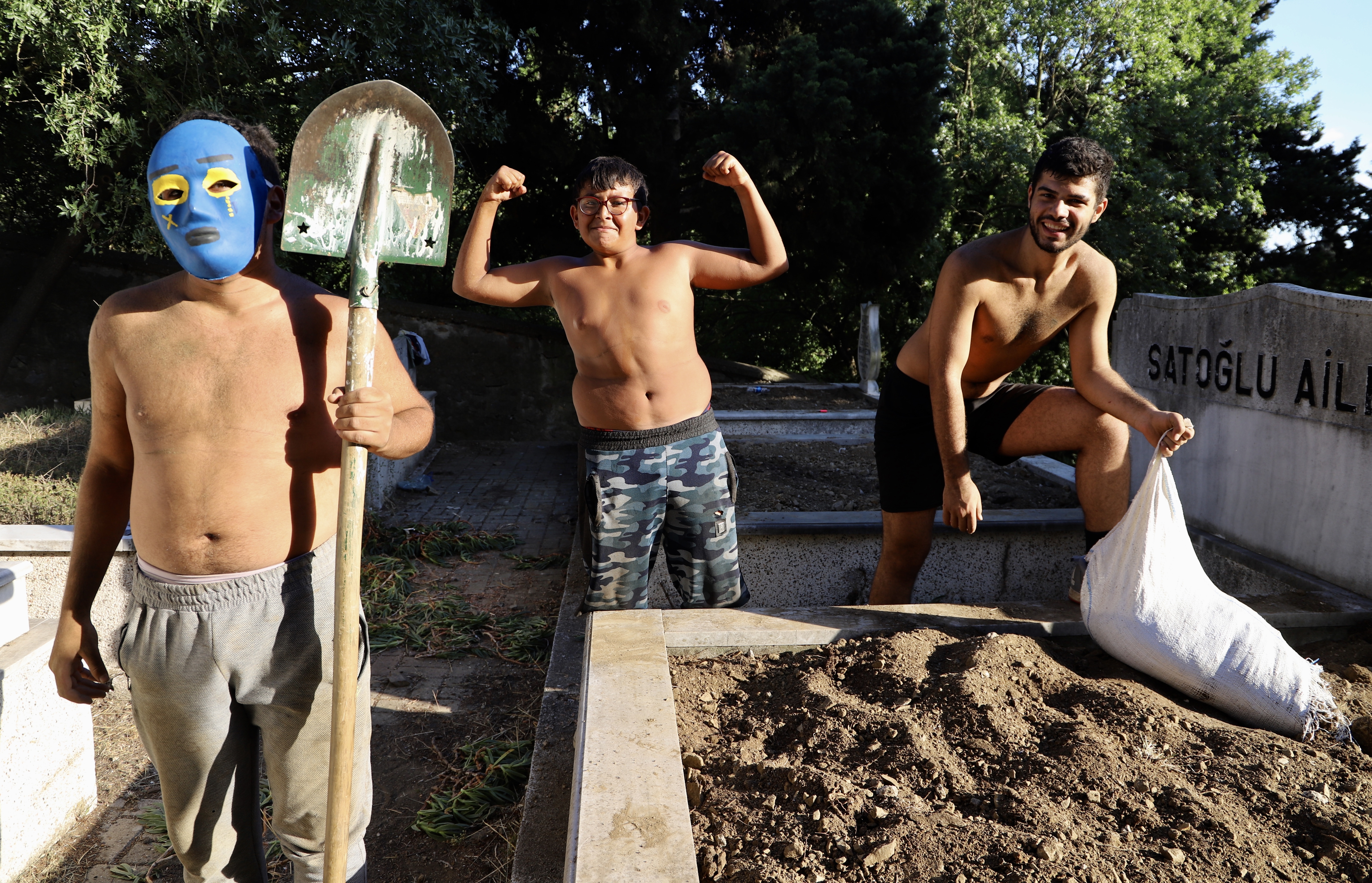First taken in 1339, Üsküdar is the first place in Istanbul where ‘Turkishness settled in and made its nest,’ as the poet Yahya Kemal put it. In this first half of our profile of Asian Istanbul’s most beloved quarter, we look at what made Üsküdar the ‘holy land’ of the Ottoman capital.
Few vantage points offer as wondrous a view of Istanbul as that from the wooden tables of Şemsipaşa Library in Üsküdar, the ancient quarter at the southwest entrance of the Bosporus that has been Istanbul’s gateway to Asia since 686 BC. Hidden in the courtyard of the eponymous mosque to which it is attached, known colloquially as Kuşkonmaz Camii (‘The Mosque Upon Which Birds Cannot Perch’), even in times of pandemic it is not easy to get a seat there. But you’re well rewarded if you do.
Finished in 1580, not only is the endearingly small complex itself one of Mimar (‘Architect’) Sinan’s lesser-known masterpieces, a simple white stone affair that, when seen from Europe, appears as if hovering over the water. From the inside of its small grassy courtyard whose edge abuts at the water, it’s difficult to determine if you’re at the end of the world or the beginning.
This singularness is compounded by the fact that Şemsipaşa also lies at the exact point where the notorious southern lodos collides with the northern karayel (‘black wind’), a perpetual gust that prevents anything from perching atop this place of worship, as per the architect’s wishes.
Soon the muezzin sounds, signaling the afternoon call to prayers. For centuries one of Istanbul’s two holiest districts, all around central Üsküdar mosques fill up with the faithful, pious droplets toward a more virtuous pool. Daytime worshippers here are of two types: municipal workers praying through face masks and neon vests and scraggly bearded students from one of the seminaries for which Üsküdar has long been known.
Too small to include a women’s section, the fairer sex does not enter at prayer times. Instead, they remain in the library or take selfies in the nave of the wall along the water, as two estivally clad girls are doing just now. Surveying it all from the corner is the chief librarian, who savors an unhurried puff as the men rush off to prayer. Her baby-blue dress, bleached blond hair, and white high-tops confuse none as to which Turkey her heart resides.
A slower imperial pace
Arriving in Üsküdar by ferry, the untrained eye can be forgiven for thinking oneself in a different realm. From a distance, the monolithic blemish of Turkish modernity—the ubiquitous pink-top, grey-body block flats that many fear will tumble with the next earthquake—is hidden from sight.
First ashore is Mimar Sinan’s exquisite Mihrimah Sultan Mosque, known colloquially as İskele Camii (the Wharf Mosque). Also designed by the greatest palace architect in Ottoman history, a Christian-born scion of the empire’s devshirme system,[1] Mimar Sinan was not merely at the height of his powers when commissioned by the 17-year old Mihrimah, daughter of Suleiman the Magnificent, to build her a mosque in 1540. He was also madly in love with her.
Yet Mihrimah, whose name means ‘the sun and the moon’ in Persian, was nothing if not a flirt. Though the author of more than 300 of the empire’s greatest works, Sinan never got the girl. Worse, while completing Mihrimah’s masterpiece, he spent 14 years without laying eyes on his beloved. When they did meet again, it was only so she could commission another namesake from the master.
Undaunted by unrequited love, Sinan set about building her a star at the other end of the capital to complement the moon he’d made her in Üsküdar. Set on the sixth hill at Edirnekapı, the highest point of historic Istanbul, each year on Mihrimah’s birthday, the first day of spring, as the moon rises over İskele Camii in Asia, the sun sets at Mihrimah Mosque in Europe, a sonnet set in stone by the greatest Ottoman composer.
Dusk of the matriarchs
Perched between these two matriarchal mosques is the Ahmed III Çeşmesi, one of Turkey’s most handsome fountains. Though Londoners had to wait until 1859 to get their first water fountain—the distribution of drinking water until then controlled by private monopolies overcharging for choleric muck[2]—Islamic cities such as Ottoman Constantinople, Safavid Isfahan, and Mamluk Cairo placed a special importance on providing free access to the precious potable since the 15th century.

Fountains were far from the only thing Sultan Ahmed III had erected during his celebrated ‘Tulip Reign’. Across the street lies Yeni Valide Camii, or New Queen Mother Mosque, which Ahmed commissioned for his mother Gülnuş Sultan in 1710. With baroque around the corner, Yeni Valide was not merely the last hurrah of the Ottoman classical period. It is also a paean to the last of the great Ottoman matriarchs—yet another Greek concubine who rose to govern what was then the largest empire on earth.
Therein lies the first great irony of Üsküdar. At the height of its power in the 16th and 17th centuries, the Ottoman Empire was largely run by a series of Balkan Christian slave girls. Though historians have berated the recklessness and nepotism with which they often misruled it, nowhere is the legacy of these kidnapped courtesans more firmly set in stone than Anatolian Istanbul’s most conservative Muslim quarter.
Gateway to the east
Sadly, few who pass through central Üsküdar have time to unwind in 16th century courtyards, and only stray dogs stop off for a sip at Ahmed III’s fountain. Though suits and ties are unheard of, Üsküdar has still become Anatolian Istanbul’s chief transportation hub over the past decade. In addition to its many ferry connections, Üsküdar also now boasts the ambitious Marmaray system, a 76km light-rail finished in 2013 that tunnels under the Bosporus to connect Istanbul’s furthest-flung suburbs from both continents.
President Recep Tayyip Erdoğan’s first signature ‘pharaonic’ project, the Marmara was the fulfillment of a 19th century Ottoman dream to tunnel under the Bosporus. Where Abdülhamid II’s French consortium failed in the 1890s, Erdoğan’s Japanese contractors delivered. And that’s hardly all. Hundreds of feet beneath the Ahmed III Fountain, the Marmara connects to Istanbul’s latest metro line, the M5, which begins in Üsküdar and terminates deep in the Anatolian suburbs of Çekmeköy.
This is another of Üsküdar’s many ironies. As the district most famed for its mosques, medreses, tekkes[3], and holy tombs, not to mention the largest cemetery in Turkey, the majestic 700-year old Karacaahmet Mezarlığı, Üsküdar has long been hailed for its sükût, or near-holy silence. So how can the spiritual heart of Turkish Constantinople withstand the passage of two million flustered commuters each day?
Beloved by its prosperous, conservative residents such as President Erdoğan, Üsküdar is being championed for development precisely because of its robust pious bonafides. A place that has yet to fall fully unawares through the trapdoor of modernity, with the arrival of the Marmaray and the M5—pet projects of great pride for President Erdoğan—there’s a feeling it’s being pulled into the future faster than it cares to go.
Though its residents are universally proud of inhabiting a world apart, they are aware that Üsküdar’s peace and prosperity depend in part on diverging forces. So long as that delicate balance is not severed, Üsküdar will remain to Istanbul—the confident, pious, and prosperous focal point of the urban Anatolian experience—what Turkey is to the world: proof that Islam, capitalism, and modernity, with a dash of democratic salt, is still a dish worth serving.
The Road to Asia
To be sure, Üsküdar’s role as a major Eurasian transit hub is nothing new. Since its founding as Chrysopolis (‘City of Gold’) in 686 BC, Üsküdar has played a critical role in world history. Founded as a Greek colony, it was not long before the Persians began eyeing the Asian pearl. Seized by Darius in the sixth century BC, it was retaken by Spartans in the fifth before being subsumed into Rome in 79 AD.
Its significance crested when Constantine I defeated Licinius, the emperor of the east, at the Battle of Chrysopolis in 324 AD. This paved the way for the first Christian emperor not merely to reunite the Roman Empire, but move its entire nexus eastward with the founding of Constantinople just across the Straits in 330 AD. Now at the heart of the world’s greatest polity, Chrysopolis became the point of departure for every Roman legion en route to Persia, Armenia, and Mesopotamia.
Even in antiquity, all roads east began in Üsküdar. In a sense, they still do. Given that nearly a quarter of the population of the Anatolian Peninsula lives in Istanbul’s vast sprawl, the Marmaray and M5 are but new and improved imperial roads leading to the high-rise doorstep of millions of residents of the Turkish republic.

Shorn by geography
Geographically vulnerable as most harbors are, Chrysopolis was better suited to commerce than war. This is why nothing remains of its Roman or Byzantine origins: unlike Constantinople, within whose ancient walls the treasures of antiquity still linger, those of Chrysopolis were obliterated with each passing invasion. And plenty there were.
First came the Arabs, whose Abbasid armies took and held Chrysopolis in 782 AD. Though lacking the naval power to seize Constantinople, they camped out for several years at what is now the hilltop Karacaahmet Cemetery. Four centuries later came the Crusaders and their Venetian allies, who occupied and ravaged both Chalcedon (modern Kadıköy) and Chrysopolis en route to capturing Constantinople in 1204.
By 1339 it was the Turks’ turn to try. Unlike the Arabs and Franks, however, the Ottomans were in it for the long haul. Under the leadership of Orhan Gazi they not only seized but held Üsküdar, by then known as Scutari, for the next seven hundred years. Bar a brief Italian occupation after WWI, they never let it go.
Scutari, rendered in Turkish as ‘Üsküdar,’ had never been the endpoint; that was always Constantinople, just across the Bosporus on the European side of the straights. As such, the Ottomans used their 114-year head-start to mold Üsküdar to their heart’s desire. As a result of this advanced flank honeymoon, nowhere in Istanbul is more Turkish.
At the risk of simplification, this means the adoption of Turkish Anatolian life to antiquity’s greatest polis: the mosque, han,[4] and dervish lodge as center of social life; class-transcendent Islamic social ties (with Muslims first among ‘peoples of the book’); and Turkish, rather than Greek, Arabic, Persian, or Armenian, as the lingua franca.
“[As] the first step in the conquest of Istanbul,” writes historian Sinan Yilmaz, “[the seizure of Üsküdar] was the harbinger of things to come.”[5] But it was also so much more. For the Turks who’d go on to put Constantinople under new management, Üsküdar was a beginning and a base—the Plymouth Rock of the Turkish Straits.
Peopling Üsküdar
Two censuses taken four hundred years apart attest to this. In the first, written in the 1630s, Ottoman chronicler Evliya Çelebi writes of how Mehmet the Conqueror brought people from all over the Balkans, Aegean, Anatolia, and Near East to populate his new imperial capital.
Bringing with them the “traditions that [would] constitute the Ottoman cultural mosaic,” the early sultans brought Greeks from the Peloponnese to Fener, Salonika Jews to Tekfur Sarayı, Balat Roma to Balat, Palestinians to Tahtakale, Albanians to Silivrikapısı, Armenians from Tokat and Sivas to Sulumanastır, Europeans to Little Galata, and Anatolian Turks to Üsküdar.[6]
Note this last distinction. Since 1923, to live in Turkey is to imagine oneself a (post-Anatolian) Turk. While such a moniker clearly did not apply to the vast majority of Istanbul residents well into the last century, it actually did to Üsküdarlıs (the Turkish morphology of what English speakers might call ‘Üsküdarite’). This is what makes it so special: it’s the one place where Anatolian Turks can have their cake and eat it, too. They can be—and are—traditional but urbane, conservative but tolerant, faithful but cosmopolitan, all without aping a superior other, whether real or imagined.
The second census, taken in Ayazma Mahallesi, a leafy, prosperous quarter along the coastline, reveals Üsküdar’s trans-Anatolian bonafides even better.
Of its 2,000 inhabitants in 2000, 900 were born in Istanbul, while the remaining 1,100 hailed from 75 of Turkey’s 81 provinces, the highest concentration from the Black Sea. Despite straddling the entrance of the world’s most important waterway, only one person in Ayazma had been born outside Turkey in the year 2000—a stunning reversal on previous centuries.[7]

Making an Üsküdarlı
After nine tumultuous years in Parisian exile, the renowned Ottoman poet Yahya Kemal returned to Istanbul on the eve of WWI. Looking to anchor himself “in the lifestyle created by Turks in the context of Islam,” there was never any doubt as to where he might settle. After the ravages of the 19th century, he was convinced, only Üsküdar had retained the real meaning of what it was to be an urbane Turkish Muslim: peaceful, generous, modest, pious, courteous, and caring.
The rest of the Ottoman capital, he lamented, had been given over to a new iron cage—a frenzied pursuit of lights and money, fleeting pleasures and permanent new woes. As he writes of Beyoğlu, the European quarter of embassies, bars, and brothels, the bubbling chaos of Babel reborn:
After first taking her money, Beyoğlu took her glory, her splendor, her appeal, everything Istanbul had; she rose, she grew, she expanded, she became uncontrollable… And this heap of buildings where not one stone is imbued with the spirit of the past is going to grow even more because Muslim real estate owners are competing with rich Christians for her construction.[8]
“We Turks of today have settled in places like Şişli, Nişantası, Kadıköy, and Moda,” he continues, listing off what are still Istanbul’s most coveted neighborhoods. “[They] are like small cities, but are dry and arid, bereft of the Muslim spirit. Look at Üsküdar,” he warns, “and then look at Kadıköy. Next to Üsküdar, Kadıköy reminds one of Tatavla,” a raucous Greek quarter north of Taksim Square on the European side once notorious for its distilleries and street gangs.[9]
A token of generosity
Writing extensively about the Üsküdar of his childhood, Ahmed Yüksel Özemre stresses how even banal encounters conspired to the kind of social harmony that Kemal craved. When it came time to pay at the grocery store, for example, shopkeepers would gaze at the wall so as not to know the contents of their customers’ purse (a habit that continues today when entering one’s pin). Getting home was also a trial, since people went to great pains to conceal their purchases, lest they embarrass a less fortunate neighbor.
Even passenger ferries conspired to these norms. Never, for example, would you take another regular passenger’s seat when crossing the Bosporus. Even if a person didn’t board, to leave their seat empty was to honor their absence.
Given its peace and beauty, Özemre concludes, it’s easy to live in Üsküdar. Much harder, he warns, to be an Üsküdarlı. Not like yesteryear, he laments, “when even street dogs, vagabonds, hoodlums, dope fiends, and lunatics were graceful and articulate, had a sense of honor, and a feeling for justice.”
Ferhat Karaçak, a retired leftist writer who spent four years in prison after the 1980 coup, would agree. Pontificating from his perch at the Coastal Beautification and Fisherman’s Protection Association, a popular teahouse in Salacak, Üsküdar’s prosperous and leafy quarter across from the Maiden’s Tower, he says as much.
“Love and solidarity are what make Üsküdar go round. But crazy folk are important, too! They’re social rehabilitators,” he stresses. “Paeans to public health. It’s crazy people that put a healthy distance between you and your daily problems.”
Becoming Üsküdar
In addition to a healthy abundance of affable screwballs, wo things affected urban life in the centuries following the Turkish conquest and settlement of Constantinople, writes Ekrem Işın.[10] First were the economic institutions—the markets, hans, and guilds and the social stratification that came with them. Second were the religious institutions, namely mosques and Sufi lodges.[11]
Long a trade hub with the east, it was only after the conquest that Üsküdar took on a unique religious importance of its own. Already the site of Istanbul’s oldest Muslim cemetery, Üsküdar soon became the ceremonial departure point for pilgrims from all over the empire making the Hajj. It was from İskele Square by today’s ferry pier that the Surre-i Hümâyûn, or the Sacred Caravan, set off on sacred white camels bearing gifts for the Sharif of Mecca until 1918, when the capital fell to Perfidious Albion.

It also became a hub for many important Sufi lodges. As Işın points out, the district already had an important military and ulema-based population structure prior to the conquest. Given the piety of the early post-conquest sultans, the first three of whom were attached to one lodge or another, Üsküdar soon flourished as the site of these centers of socialization and learning.
On the eve of the republic, Üsküdar boasted over 200 separate dergâh, as the lodges were known. Remarkably, these mystical places of worship only added to Üsküdar’s spirit of tolerance. As Aydın Muhtaroğlu, the gardener at the celebrated Aziz Mahmud Hüdayi’s tomb, put it: “In [Ottoman] days there was a lodge for every taste and temperament.”
The route to Mecca from much of Eurasia, the Indians, Afghans, and Uzbeks also built their lodges in Üsküdar. Nor were these bodies restricted to the socially respectable. “Even the lazy and unemployed had lodges strictly for the lazy and unemployed!” jokes Aydın the Gardener.
Then as now, it seems, there’s a place in Üsküdar for anyone willing to abide by a few ancient norms. “Though lumpen and other radicals get bored here very quickly,” Aydın jokes, using language more appropriate to his stint as an ultranationalist partisan in the 1970s, “the pious, conservative, relaxed, and optimistic are right at home.”
The second part of this story is now published here.
References
[1] Whereby Christian children from conquered territories, mostly the Balkans, were taken from their families and raised at court in Istanbul to form the nucleus of a new Ottoman governing elite loyal to none but the Sultanate.
[2] https://www.atlasobscura.com/places/the-first-public-drinking-fountain-london-england
[3] Dervish, i.e. Sufi lodges
[4] Which roughly means inn, lodge, or caravansary
[5] Sinan Yilmaz. Üsküdar Kitabı.
[6] See Evliya Çelebi, Seyahatname, I, Dersaadet, 1314, p.114-115.
[7] Tarık Sipahi, Ayazma Mahallesi Üsküdar, 2011.
[8] Quoted in Ekrem Işın, Everyday Life in Istanbul, p.189. Yapi Kredi Yayinevi.
[9] Tatavla was renamed Kurtuluş in 1929. For more on the latter, see: https://www.resetdoc.org/story/a-journey-through-kurtulus/
[10] See Everyday Life in Istanbul: Social Historical Essays on People, Culture, and Spatial Relations (2001).
[11] Sufism is a mystical form of Islamic worship that stresses the “renunciation of worldly things, purification of the soul, and the mystical contemplation of God’s nature.” See: https://www.nytimes.com/2017/11/24/world/middleeast/sufi-muslim-explainer.html
Cover Photo: European Istanbul seen from the coast of Üsküdar (all photos by E. Pheiffer)
Follow us on Facebook, Twitter and LinkedIn to share and interact with our contents.
If you like our stories, analyses and dossiers, sign up for our newsletter (twice a month).


